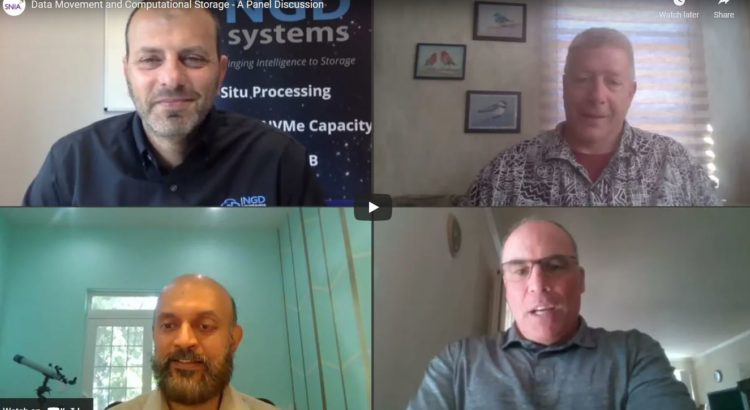Recently, the SNIA Compute, Memory, and Storage Initiative hosted a live webcast “Data Movement and Computational Storage”, moderated by Jim Fister of The Decision Place with Nidish Kamath of KIOXIA, David McIntyre of Samsung, and Eli Tiomkin of NGD Systems as panelists. We had a great discussion on new ways to look at storage, flexible computer systems, and how to put on your security hat.
During our conversation, we answered audience questions, and raised a few of our own! Check out some of the back-and-forth, and tune in to the entire video for customer use cases and thoughts for the future.
Q: What is the value of computational storage?
A: With computational storage, you have latency sensitivity – you can make decisions faster at the edge and can also distribute computing to process decisions anywhere.
Q: Why is it important to consider “data movement” with regard to computational storage?
A: There is a reduction in data movement that computational storage brings to the system, along with higher efficiencies while moving that data and a reduction in power which users may not have yet considered.
Q: How does power use change when computational storage is brought in?
A: You want to “move” compute to that point in the system where operations can be accomplished where the data is “at rest”. In traditional systems, if you need to move data from storage to the host, there are power costs that may not even be currently measured. However, if you can now run applications and not move data, you will realize that power reduction, which is more and more important with the anticipation of massive quantities of data coming in the future.
Q: Are the traditional processing/storage transistor counts the same with computational storage?
A: With computational storage, you can put the programming where it is needed – moving the compute to that point in the system where it can achieve the work with limited amount of overhead and networking bandwidth. Compute moves to where the data sits at rest, which is especially important with the explosion of data sets.
Q: Does computational storage play a role in data security and privacy?
A: Security threats don’t always happen at the same time, so you need to consider a top-down holistic perspective. It will be important both today and in the future to consider new security threats because of data movement.
There is always a risk for security when the data is moving; however, computational storage reduces the data movement significantly, and can play as a more secure way to treat data because the data is not moving as much. Computational storage allows you to lock the data, for example, medical data, and only process when needed and if needed in an authenticated and secure fashion. There’s no requirement to build a whole system around this.
Q: What are the computational storage opportunities at the edge?
A: We need to understand the ecosystem the computational storage device is going into. Computational storage sits at the front line of edge applications and management of edge infrastructure pieces in the cloud. It’s a great time to embrace existing cloud policies and collaborate with customers on how policies will migrate and change to the edge.
Q: In your discussions with customers, how dynamic do they expect the sets of code running on computational storage to be? With the extremes being code never changing (installed once/updated rarely) to being different for every query or operation. Please discuss how challenges differ for these approaches.
A: The heavy lift comes into play with the application and the system integration. To run flexible code, customers want a simple, straightforward, and seamless programming model that enables them to run as many applications as they need and change them in an easy way without disrupting the system. Clients are using computational storage to speed up the processing of their data with dynamic reconfiguring in cutting edge applications. We are putting a lot of effort toward this seamless and transparent model with our work in the SNIA Computational Storage Technical Work Group.
Q: What does computational storage mean for data in the future?
A: The infrastructure of data and data movement will drastically change in the future as edge emerges and cloud continues to grow. Using computational storage will be extremely beneficial in the new infrastructure, and we will need to work together as an ecosystem and under SNIA to make sure we are all aligned to provide the right solutions to the customer.
